The Egyptian Museum of Cairo
Feb 8, 2004
The Coptic Christian Church
Egypt's official religion is Islam but it has a rich history of Christianity
and Judaism. We all know the story of Moses being found in the reeds in the
Nile. One of the Jewish sites we visited is a synagogue that is suppose to
be located in the spot where this event occurred. Unfortunately no
photographs were allowed. The spot was originally the location of a
Christian church and then sold to the Jewish community and a synagogue was
constructed.
When we first arrived in Egypt and were driven from the airport to our hotel
we were pointed out a church which had a large mosaic of Mary and Joseph
with the baby Jesus escaping into Egypt on the front of the building. St.
Sargius is the oldest Christian Church in Egypt. This is a Coptic
Christian church which still has services.
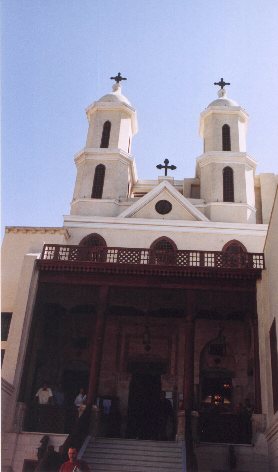 (photo 0180s)
There are many layers of civilizations throughout the Middle East. Each
society just builds on top of the old. This church was built upon old
Roman ruins and thus from street level it looks like it is floating above
the rest of the buildings. Thus it has acquired the nickname of "The
hanging church."
The church is very small so taking pictures, even with a flash and wide
angle lens, is difficult.
(photo 0180s)
There are many layers of civilizations throughout the Middle East. Each
society just builds on top of the old. This church was built upon old
Roman ruins and thus from street level it looks like it is floating above
the rest of the buildings. Thus it has acquired the nickname of "The
hanging church."
The church is very small so taking pictures, even with a flash and wide
angle lens, is difficult.
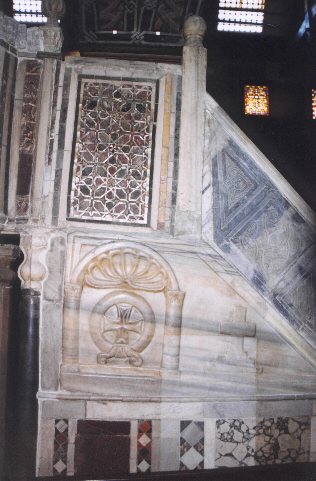 (photo 0181s)
This is the beautiful alabaster pulpit which contains the Coptic cross.
(Marie: Buy a couple of postcards if you get the chance)
(photo 0181s)
This is the beautiful alabaster pulpit which contains the Coptic cross.
(Marie: Buy a couple of postcards if you get the chance)
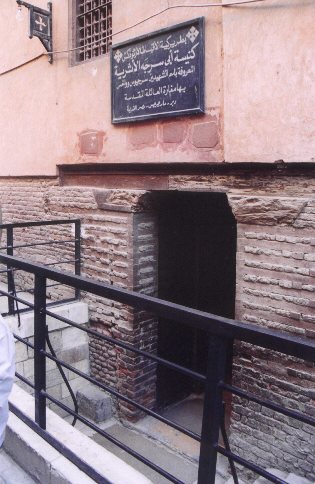 (photo 0182s)
Once we left the church we were taken to the location where Joseph, Mary and
Jesus were suppose to have lived when they were in Cairo.
Again, no photographs were allowed (Marie, buy some postcards) and it was
strictly enforced. The best I could do is show this entrance to the
location. A thousand years of new city have been built upon the ancient
site and it seems strange to walk into a basement which at one time was at
street level.
Whether the synagogue is the real location where Moses was found, or whether
this is the real location of where the Holy family lived while in Cairo is
not necessarily true, however, it is the truth of the faithful and I guess
that is what is important.
The Cairo Museum
Although the Cairo museum is the last subject I will cover on my messages
about our Egyptian trip it was the first place we had stopped two weeks
earlier. This is a good place to start any trip because it gives a vast
overview of what wonders you are about to behold and in one place you are
exposed to the different artistic techniques as they are developed through
the ages. But, at this stage of the program it is also overwhelming.
(photo 0182s)
Once we left the church we were taken to the location where Joseph, Mary and
Jesus were suppose to have lived when they were in Cairo.
Again, no photographs were allowed (Marie, buy some postcards) and it was
strictly enforced. The best I could do is show this entrance to the
location. A thousand years of new city have been built upon the ancient
site and it seems strange to walk into a basement which at one time was at
street level.
Whether the synagogue is the real location where Moses was found, or whether
this is the real location of where the Holy family lived while in Cairo is
not necessarily true, however, it is the truth of the faithful and I guess
that is what is important.
The Cairo Museum
Although the Cairo museum is the last subject I will cover on my messages
about our Egyptian trip it was the first place we had stopped two weeks
earlier. This is a good place to start any trip because it gives a vast
overview of what wonders you are about to behold and in one place you are
exposed to the different artistic techniques as they are developed through
the ages. But, at this stage of the program it is also overwhelming.
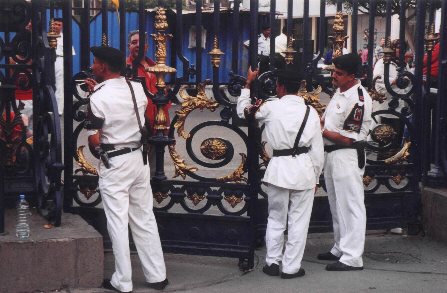 (photo 0184s)
Getting into the museum is a time consuming event. Guards everywhere.
This is when you are glad you are with a tour group because the bus pulled
up to the front gate and we were escorted to the first of three security
points we had to pass through. Each time our equipment was x-rayed and we
were scanned. This is when I learned to only carry enough film for the
day's exploration. No need to expose all my film to so many gamma rays.
(photo 0184s)
Getting into the museum is a time consuming event. Guards everywhere.
This is when you are glad you are with a tour group because the bus pulled
up to the front gate and we were escorted to the first of three security
points we had to pass through. Each time our equipment was x-rayed and we
were scanned. This is when I learned to only carry enough film for the
day's exploration. No need to expose all my film to so many gamma rays.
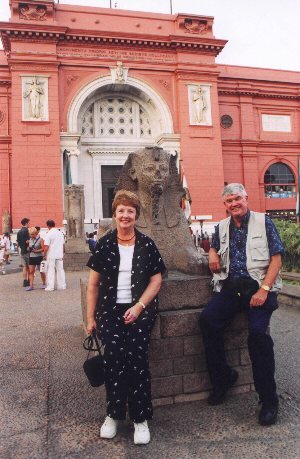 (photo 0183s)
Naturally we were very excited at our very first chance to stand next to a
sphinx which had been carved over 3,000 years ago.
Treasures of Tut
The Cairo museum has treasures going back to the stone age. It has a stone
shield which has the earliest depiction of the unification of Upper and
Lower Egypt - on one side is depicted King Narmer, wearing the bowling pin
"White Crown" of the South, triumphing over the people of the Delta. On the
opposite side is King Narmer wearing the unified crown of both southern and
northern Egypt. 5,000 years of history all under one roof.
(photo 0183s)
Naturally we were very excited at our very first chance to stand next to a
sphinx which had been carved over 3,000 years ago.
Treasures of Tut
The Cairo museum has treasures going back to the stone age. It has a stone
shield which has the earliest depiction of the unification of Upper and
Lower Egypt - on one side is depicted King Narmer, wearing the bowling pin
"White Crown" of the South, triumphing over the people of the Delta. On the
opposite side is King Narmer wearing the unified crown of both southern and
northern Egypt. 5,000 years of history all under one roof.
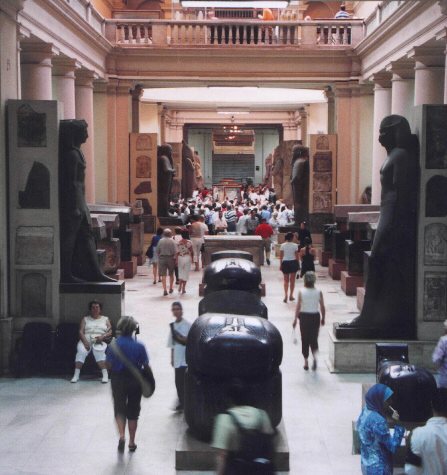 (photo 0186s)
Of course, the jewel in this crown is the exhibit displaying the findings in
the tomb of King Tutankhamen. Everything found in the tomb is either on
display in the tomb itself - you saw my earlier photo - or here in the Cairo
museum. Unlike a lot of Egyptian artifacts you don't have to go the British
Museum or a Museum in France or Berlin to see them.
(photo 0186s)
Of course, the jewel in this crown is the exhibit displaying the findings in
the tomb of King Tutankhamen. Everything found in the tomb is either on
display in the tomb itself - you saw my earlier photo - or here in the Cairo
museum. Unlike a lot of Egyptian artifacts you don't have to go the British
Museum or a Museum in France or Berlin to see them.
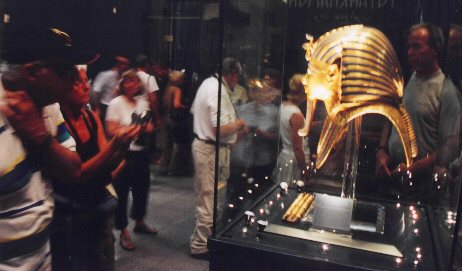 (photo 0185s)
Here you see the famous funerary mask of Tutankhamen, in gold and precious
stones, which is an exact likeness of the King. Note his beard. See the
little curl at the end? This is the way in which the Egyptians demonstrated
that this is a likeness of the Pharaoh after death. If the beard is
straight then it is a likeness while he was alive. You may note that all
the drawings of Osiris show him to be wearing a curved beard. Now this is a
bit of trivia that may come in handy some day.
Golden Throne
It would be impossible to show all of the golden artifacts found in the tomb
of King Tut. You have to be there and see them to even imagine the
magnitude of this find.
(photo 0185s)
Here you see the famous funerary mask of Tutankhamen, in gold and precious
stones, which is an exact likeness of the King. Note his beard. See the
little curl at the end? This is the way in which the Egyptians demonstrated
that this is a likeness of the Pharaoh after death. If the beard is
straight then it is a likeness while he was alive. You may note that all
the drawings of Osiris show him to be wearing a curved beard. Now this is a
bit of trivia that may come in handy some day.
Golden Throne
It would be impossible to show all of the golden artifacts found in the tomb
of King Tut. You have to be there and see them to even imagine the
magnitude of this find.
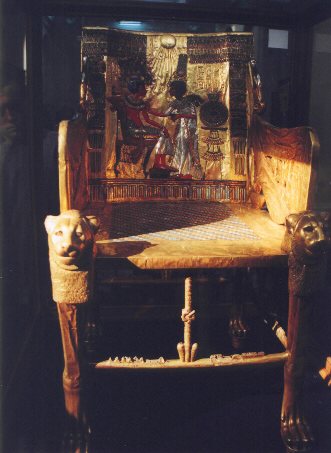 (photo 0188s)
Here is the golden throne of the King
(photo 0188s)
Here is the golden throne of the King
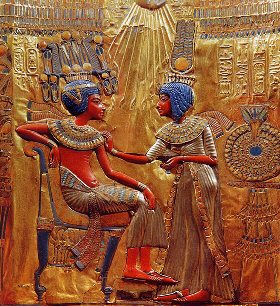 (photo 0191s)
Here is a close-up of the gold-plated wooden back of the throne showing
Ankhesenamun anointing her husband. Note the rays of the sun god Aten
showing the Pharaoh with his blessing.
King Tut's Weird Father
I figured that if I talked any more about the Cairo museum you would hit the
delete button but there is one more important aspect of Egyptian history
that you have to know about. Here is Akhenaten, King Tut's father.
(photo 0191s)
Here is a close-up of the gold-plated wooden back of the throne showing
Ankhesenamun anointing her husband. Note the rays of the sun god Aten
showing the Pharaoh with his blessing.
King Tut's Weird Father
I figured that if I talked any more about the Cairo museum you would hit the
delete button but there is one more important aspect of Egyptian history
that you have to know about. Here is Akhenaten, King Tut's father.
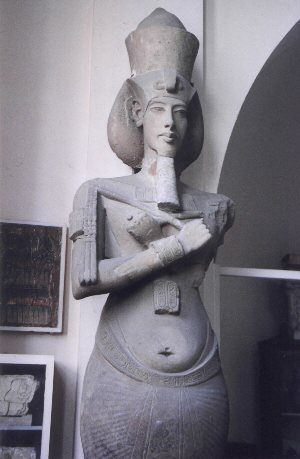 (photo 0187s)
Some suspect that it may actually be a woman, notice the elongated facial
features and protruding stomach. "Not so" says the latest theory. It is
suspected that he suffered from some genetic problem which gives people this
kind of appearance. There was a lot of inter family marriages back then in
order to keep the bloodlines "pure". It was not uncommon for the Pharaoh
to marry his sister or even a daughter.
Ken Innes notes: something about Akhenaten having the prognathous jaw from a pituitary condition known as acromegaly,
a hyperpituitary hormone imbalance, causing a condition very similar to what we see today in individuals with that problem.
Also, he had several daughters by whom he had offspring.
(photo 0187s)
Some suspect that it may actually be a woman, notice the elongated facial
features and protruding stomach. "Not so" says the latest theory. It is
suspected that he suffered from some genetic problem which gives people this
kind of appearance. There was a lot of inter family marriages back then in
order to keep the bloodlines "pure". It was not uncommon for the Pharaoh
to marry his sister or even a daughter.
Ken Innes notes: something about Akhenaten having the prognathous jaw from a pituitary condition known as acromegaly,
a hyperpituitary hormone imbalance, causing a condition very similar to what we see today in individuals with that problem.
Also, he had several daughters by whom he had offspring.
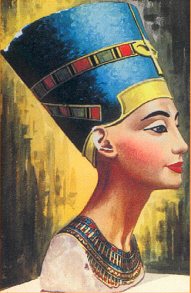 (photo 0194s)
Everyone is familiar with King Tut's mother, Queen Nefertiti. Unfortunately
this bust is located in the Berlin museum.
But the plot thickens............
The Religious Heritic
Remember how I had you remember the names of all the Egyptian gods and goddesses? Osiris, Isis, Horus, Hathor, Ra, Amon, Sobek,
and the rest? Well, forget them - That's what Akhenaten and Nefertiti, King Tut's dad and mother, said.
(photo 0194s)
Everyone is familiar with King Tut's mother, Queen Nefertiti. Unfortunately
this bust is located in the Berlin museum.
But the plot thickens............
The Religious Heritic
Remember how I had you remember the names of all the Egyptian gods and goddesses? Osiris, Isis, Horus, Hathor, Ra, Amon, Sobek,
and the rest? Well, forget them - That's what Akhenaten and Nefertiti, King Tut's dad and mother, said.
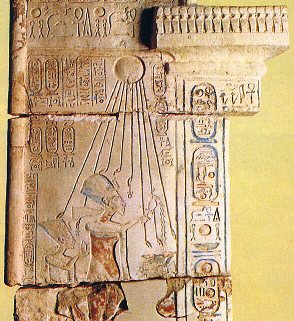 0190s
It was short-lived, but left a profound mark on human thought. Akhenaten led the revolution to allow men to appeal directly to
god without going through priests. He got rid of all the intermediate gods and in order to avoid confusion he gave the name Aten
to the absolute supreme god Ra. All men were created equal to each other and are considered brothers. The pharaoh was the prophet
of Aten. Above you can see one of the very view reliefs of Akhenaten and his queen being touched by the hands (rays of sun beams)
from the sun god Aten. What a novel idea. One god, men can appeal directly to him and don't have to pay homage to the priests -
can you imagine the religious establishment being shaken to the core? Sound familiar?
Well, try as he might to get rid of the minor gods a thousand or more years of tradition are not easily erased. When Akhenaten died
in 1354 his son, Tutankhamen, allowed the re-establishment of the old religions and the priests made every effort to erase any memory
of Akhenaten from the face of the earth. Thus you don't see many of his temples or shrines around Thebes.
0190s
It was short-lived, but left a profound mark on human thought. Akhenaten led the revolution to allow men to appeal directly to
god without going through priests. He got rid of all the intermediate gods and in order to avoid confusion he gave the name Aten
to the absolute supreme god Ra. All men were created equal to each other and are considered brothers. The pharaoh was the prophet
of Aten. Above you can see one of the very view reliefs of Akhenaten and his queen being touched by the hands (rays of sun beams)
from the sun god Aten. What a novel idea. One god, men can appeal directly to him and don't have to pay homage to the priests -
can you imagine the religious establishment being shaken to the core? Sound familiar?
Well, try as he might to get rid of the minor gods a thousand or more years of tradition are not easily erased. When Akhenaten died
in 1354 his son, Tutankhamen, allowed the re-establishment of the old religions and the priests made every effort to erase any memory
of Akhenaten from the face of the earth. Thus you don't see many of his temples or shrines around Thebes.
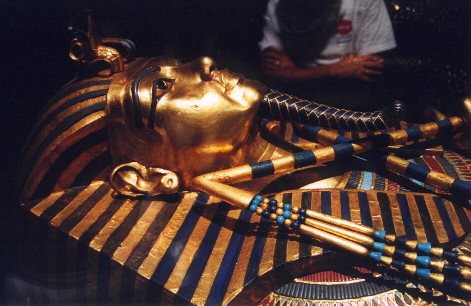 0195s
King Tut, however, young as he might have been when he was killed/died, was buried with the richest of treasures.
Happy ending?
Egypt and the Movie Star
I imagine most of you have seen the movie "Cleopatra" staring Elizabeth Taylor. Does this look familiar?
0195s
King Tut, however, young as he might have been when he was killed/died, was buried with the richest of treasures.
Happy ending?
Egypt and the Movie Star
I imagine most of you have seen the movie "Cleopatra" staring Elizabeth Taylor. Does this look familiar?
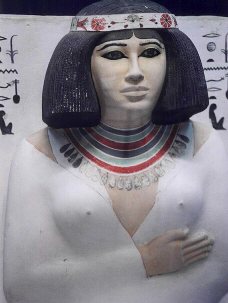 (photo 0193s)
This is a statute of Nofret, wife of Rahotep, found at Maydum not far from the pyramid of Snefru. Rahotep was the Director of
Expeditions and High Priest. Elizabeth Taylor saw this statue in the Cairo museum and she insisted her dress in "Cleopatra" be
modeled after it. And Janet Jackson thought she was be erotic. There is nothing new under the sun.
With a tear in my eye.....
It was with a tear in my eye that we attended the farewell dinner on a boat
in the Nile river - a traditional event with Grand Circle Tours.
(photo 0193s)
This is a statute of Nofret, wife of Rahotep, found at Maydum not far from the pyramid of Snefru. Rahotep was the Director of
Expeditions and High Priest. Elizabeth Taylor saw this statue in the Cairo museum and she insisted her dress in "Cleopatra" be
modeled after it. And Janet Jackson thought she was be erotic. There is nothing new under the sun.
With a tear in my eye.....
It was with a tear in my eye that we attended the farewell dinner on a boat
in the Nile river - a traditional event with Grand Circle Tours.
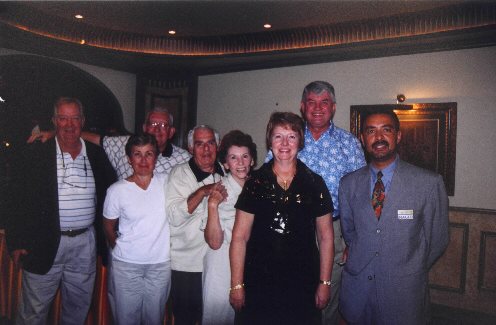 (photo 0196s)
We had to say goodbye to Frank, Barb, Rob, Bob, Doris, and the best Program
Director in all Egypt, Maged. He answered our questions, took care of our
needs, and genuinely made our visit through the ages of Pharaohs and
pyramids and tombs and camels and cruise up and down the Nile the most
pleasant and memorable experience. I would return in a minute.
(photo 0196s)
We had to say goodbye to Frank, Barb, Rob, Bob, Doris, and the best Program
Director in all Egypt, Maged. He answered our questions, took care of our
needs, and genuinely made our visit through the ages of Pharaohs and
pyramids and tombs and camels and cruise up and down the Nile the most
pleasant and memorable experience. I would return in a minute.
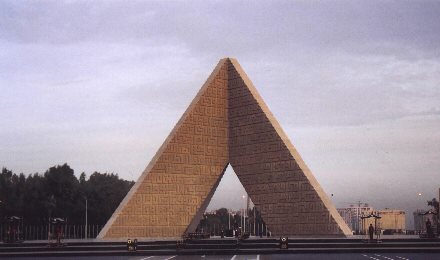 (photo 0197s)
We were up at 5:00 a.m. and packed and off to the Cairo airport by 7:00 too
catch a 10:00 a.m. flight to JFK. On the way to the airport we passed our
last, and most recently built, tomb - the Tomb of the Unknown Soldier and
the Tomb of the beloved Anwar Sadat. With just a few Egyptian Pounds in my
pocket I picked up a couple of souvenir coffee cups at the airport only to
learn they wanted U.S. dollars.
It was a long flight home but we flew over the Nile delta and I saw
Alexandria by air. Then across to toe of the boot of Italy, the Swiss alps,
Germany, and then across the Atlantic to land in New York. The next time I
hear someone complain about smog in the U.S. I will invite them to fly over
Cairo.
So ends the story of my trip to Egypt. I will be saving Jordan and Israel
for another day - after we return from our trip to Morocco which starts
tomorrow, Tuesday, Feb 10th. We return on Feb 28th. Naturally we will be
thinking of each of you.
(photo 0197s)
We were up at 5:00 a.m. and packed and off to the Cairo airport by 7:00 too
catch a 10:00 a.m. flight to JFK. On the way to the airport we passed our
last, and most recently built, tomb - the Tomb of the Unknown Soldier and
the Tomb of the beloved Anwar Sadat. With just a few Egyptian Pounds in my
pocket I picked up a couple of souvenir coffee cups at the airport only to
learn they wanted U.S. dollars.
It was a long flight home but we flew over the Nile delta and I saw
Alexandria by air. Then across to toe of the boot of Italy, the Swiss alps,
Germany, and then across the Atlantic to land in New York. The next time I
hear someone complain about smog in the U.S. I will invite them to fly over
Cairo.
So ends the story of my trip to Egypt. I will be saving Jordan and Israel
for another day - after we return from our trip to Morocco which starts
tomorrow, Tuesday, Feb 10th. We return on Feb 28th. Naturally we will be
thinking of each of you.
![]()
Jump Station
Go to The Egyption Museum of Cairo - Under Construcion
Go to The Religious Faiths - Under Construction Go to Street Scenes of Cairo - Under Construction Go to Who are the Gods? - Under Construction. Go to Chapter 9: The Khan el-Khali Bazaar - Under Construction Go to Chapter 8: The Pyramids - Under Construction Go to Chapter 7: East Thebes and the Temple of Luxor - Under Construction Return to Chapter 6: The Pyramids.Return to Chapter 5: Karnak Temple at Luxor and the Temple of Hathor at Dendera.
>Return to Chapter 4: Kom Ombo, Edfu, Karnak and Dendera.
Return to Chapter 3: Cruising Down the Nile.
Return to Chapter 2: Abu Simbel and Aswan.
Return to Chapter 1: Introduction to Egypt.
Read about my version of The Gods of Egypt and Diagram of Temples.
Return to Belli's Home Page(This page is constantly under reconstruction so come back again.)
![]()
![]()
![]()
![]()
![]()
![]()
![]()
![]()
![]()
For more information about our travels write to![]() Belli.
Belli.
